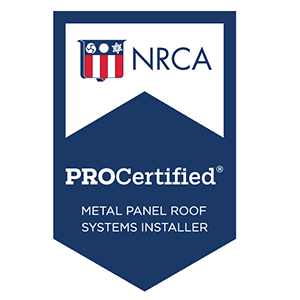NRCA launches new certification for roof system installers

|
NRCA is pleased to announce experienced installers who demonstrate substantial skills and knowledge of metal panel roof systems now can apply to become NRCA ProCertified® Metal Panel Roof Systems Installers. The certification was developed in partnership with the Metal Construction Association and Metal Roofing Alliance.
NRCA ProCertification is NRCA’s national certification initiative to create a competent, sustainable and high-performing roofing industry workforce. Certifications now available include NRCA ProCertified Architectural Metal Flashings and Accessories Installer, NRCA ProCertified Asphalt Shingle Systems Installer, NRCA ProCertified Clay and Concrete Tile Systems Installer, NRCA ProCertified EPDM Systems Installer, NRCA ProCertified Metal Panel Roof Systems Installer, NRCA ProCertified Thermoplastic Systems Installer and NRCA ProCertified Roofing Foreman.
Additional information about NRCA ProCertification is available at nrca.net/procertification.
Workers quit jobs because of low pay, lack of advancement
The Pew Research Center reports workers who quit jobs in 2021 blame their departures on low pay, lack of advancement opportunities and feeling disrespected at work, according to constructiondive.com. The think tank surveyed 6,627 nonretired U.S. adults between Feb. 7 and Feb. 13, including 965 people who say they left a job by choice in 2021.
Individuals who quit and are now employed elsewhere are more likely to say their current job has better pay, more opportunities for advancement and more work-life balance and flexibility, according to the Pew Research Center’s report.
Thirty-one percent of workers who left jobs in 2021 say they did so because of disruption from the COVID-19 pandemic. Child care challenges led to a high percentage of departures by workers with children younger than 18 living at home.
Workers who quit jobs during 2021 cite low pay (63%), no opportunities for advancement (63%) and feeling disrespected at work (57%), with at least one-third saying these were major reasons they quit. They also cite a lack of scheduling flexibility, inadequate benefits and a desire to move to a different area.
The Department of Labor reported the number of workers who left their jobs as a percent of total employment reached 3% in November 2021—the highest rate since 2000—before falling to 2.8% in January. Job openings in 2021 also hit a record, remaining above 10 million from June 2021 through December 2021.
There were 11.3 million job openings in January, which is close to the 11.4 million record set in December 2021. In addition, the jobless rate decreased from 4% in January to 3.8% in February. The labor force participation rate—the proportion of workers either employed or seeking jobs—increased to 62.3% in February but still is 1.1 percentage points below the pre-pandemic level.
More women are entering the construction industry

|
More than 1.2 million women currently are employed in the U.S. construction industry—more than ever before, according to fixr.com. Women are trailblazing their way to various roles in a male-dominated industry, including in management and as company owners.
Women comprise 47% of the U.S. workforce and 11% of the construction industry, according to the Bureau of Labor Statistics. The number of women working in the construction industry increased 54.7% from 802,000 women in 2012 to 1.2 million women in 2021, according to BLS.
One factor drawing women to the construction industry is the comparably small gender pay gap. BLS reports women earn 81.5% of what men earn across all industries. However, women’s earnings as a percentage of men’s earnings in the construction industry is 94.3%—the lowest gender pay gap across industries measured in the U.S.
Public representation of female construction workers and company outreach efforts also are attracting women to the industry.
“I have noticed an increase in the number of women who contact me about working in construction, which is a direct result of women being publicly recognized on numerous outlets,” Joan Barton, general contractor at Dirty Girl Construction Inc., Los Angeles, told fixr.com. “This has also translated into a general awareness about the need for earlier education and opportunity, as well as a specific outreach by some companies to train and hire more women.”
Women working in management and professional roles and service roles in the construction industry have increased to 17.1% and 24.6%, respectively. However, fewer women currently work in production, transportation and material moving (3.3%) and natural resources, construction and maintenance (3.7%), according to BLS. Women make up a majority of sales and office roles in construction at 71.3%.
Debra L. Hilmerson, president and CEO of Hilmerson Safety,® Prior Lake, Minn., told fixr.com encouraging young girls to try trade classes in school can help them learn about a variety of career options in the construction industry. Hilmerson already has seen some positive progress in the industry.
“Years ago, women mainly held administrative support positions such as typing, filing and answering phones. However, in the past 10 years, I’ve seen more women holding leadership positions in the field and executive positions within large construction firms,” Hilmerson said. “While this is great to see, we still have a long way to go!”
EPA sunsets ENERGY STAR® specification for roofing products

|
On June 1, the Environmental Protection Agency ended its ENERGY STAR specification for roofing products.
In 2019, the EPA sent a letter to roofing industry partners announcing it was finalizing the sunset. Stakeholders had been asked to submit comments regarding the sunset proposal, and though feedback was mixed, a range of commenters supported sunsetting the program.
In the 2019 letter, the EPA said it revised its timeline for sunsetting its ENERGY STAR specification for roofing products, acknowledging the long testing period for roofs.
Brand owners no longer can use the ENERGY STAR name and ENERGY STAR mark in association with roofing products. To minimize the cost of labeling changes and increase compliance, brand owners were encouraged to remove ENERGY STAR references on websites and in other collateral materials before June 1.
Any questions can be directed to roofproducts@energystar.gov .



